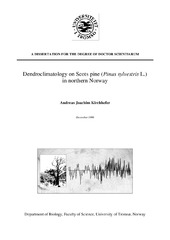| dc.contributor.advisor | Ims, Rolf | |
| dc.contributor.advisor | Lowther, Andrew D. | |
| dc.contributor.author | Narvestad, Audun | |
| dc.date.accessioned | 2020-08-17T13:27:21Z | |
| dc.date.available | 2020-08-17T13:27:21Z | |
| dc.date.issued | 2019-08-15 | |
| dc.description.abstract | Species are likely to segregate their ecological niches to minimize competition for resources, but for centrally foraging predators that breed on sub-Antarctic islands in the Southern Ocean the possibility of niche segregation may be minimal. This study is the first to examine the spatial and trophic aspects of the foraging niche of sympatrically breeding macaroni and chinstrap penguins at the poorly-studied sub-Antarctic island Bouvetøya over multiple years. To measure at-sea movements and dive behavior, 90 breeding macaroni Eudyptes chrysolophus and 49 breeding chinstrap penguins Pygoscelis antarcticus were deployed with satellite transmitters and time-depth recorders over two austral summer breeding seasons, 2015 and 2018. In addition, tracked birds were sampled for blood for biogeochemical dietary analysis. Chinstrap penguins displayed large interannual variation in foraging behavior between the two years, and dove deeper, utilized larger foraging areas during late breeding stages and showed enriched values of δ15N in the first- compared to the second- year. Conversely, macaroni penguins dove to similar depths and displayed similar values of δ15N in both years. Our results suggest that potentially low krill abundances in the waters around Bouvetøya in 2015 forced the chinstrap penguins to search for alternative prey, like myctophid fishes, which resulted in increased overlap in the two species' foraging niche. Consequently, the chinstrap penguins may have faced increased interspecific competition for prey or catabolism from food shortage. Irrespective, our findings may partly explain the decreasing number of breeding chinstrap penguins at the world's most remote island, Bouvetøya. | en_US |
| dc.identifier.uri | https://hdl.handle.net/10037/18999 | |
| dc.language.iso | eng | en_US |
| dc.publisher | UiT Norges arktiske universitet | en_US |
| dc.publisher | UiT The Arctic University of Norway | en_US |
| dc.rights.accessRights | openAccess | en_US |
| dc.rights.holder | Copyright 2019 The Author(s) | |
| dc.rights.uri | https://creativecommons.org/licenses/by-nc-sa/4.0 | en_US |
| dc.rights | Attribution-NonCommercial-ShareAlike 4.0 International (CC BY-NC-SA 4.0) | en_US |
| dc.subject.courseID | BIO-3950 | |
| dc.subject | VDP::Mathematics and natural science: 400::Zoology and botany: 480::Ecology: 488 | en_US |
| dc.subject | ecological niche | en_US |
| dc.subject | VDP::Mathematics and natural science: 400::Zoology and botany: 480::Ecology: 488 | en_US |
| dc.subject | niche segregation | en_US |
| dc.subject | VDP::Mathematics and natural science: 400::Zoology and botany: 480::Ecology: 488 | en_US |
| dc.subject | competition | en_US |
| dc.subject | VDP::Mathematics and natural science: 400::Zoology and botany: 480::Ecology: 488 | en_US |
| dc.subject | central place foraging | en_US |
| dc.subject | VDP::Mathematics and natural science: 400::Zoology and botany: 480::Marine biology: 497 | en_US |
| dc.subject | Southern Ocean | en_US |
| dc.subject | VDP::Mathematics and natural science: 400::Zoology and botany: 480::Marine biology: 497 | en_US |
| dc.subject | low krill events | en_US |
| dc.subject | VDP::Mathematics and natural science: 400::Basic biosciences: 470::Biochemistry: 476 | en_US |
| dc.subject | stable isotope analysis | en_US |
| dc.subject | VDP::Mathematics and natural science: 400::Zoology and botany: 480::Marine biology: 497 | en_US |
| dc.subject | radio telemetry | en_US |
| dc.title | An interannual study of foraging behaviour in sympatrically breeding macaroni Eudyptes chrysolophus and chinstrap penguins Pygoscelis antarcticus at Bouvetøya | en_US |
| dc.type | Master thesis | en_US |
| dc.type | Mastergradsoppgave | en_US |


 English
English norsk
norsk



